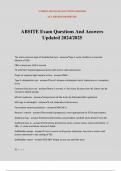©THESTAR EXAM SOLUTIONS 2024/2025
ALL RIGHTS RESERVED.
ABSITE Exam Questions And Answers
Updated 2024/2025
The most common type of choledochal cyst - answer✔Type 1-cystic, fusiform or saccular
dilation of CBD
CBD is abnormal, CHD is normal
TX with RenY hepaticojejeuenostomy with end to side anastamosis
Origin of replaced right hepatic artery - answer✔SMA
Type 5 choledochal cyst - answer✔Caroli's disease-intrahepatic ducts, lobectomy vs. transplant
for tx
Common bile duct size - answer✔6mm is normal, +1 for every 10 years over 40, 10mm can be
normal in elderly people
Mirizzi's sydrome - answer✔compression of bile ducts by distended GB or gallstone
MC bugs in cholangitis - answer✔E coli, klebsiella, Enterococcus
Pancreatitis severity prediction - answer✔APACHE-II
Ranson's criteria - answer✔Pancreatitis (prognosis), more appropriate for ETOH pancreatitis
Gallstone ileus - answer✔Intestinal obstruction, pneumobilia, calcified stone distant from GB
Gallstone ileus tx - answer✔Enterotomy proximal to stone, extract stone, close enterotomy. +/-
SBR, +/- chole and fistula closure if stable
Gallbladder polyps - answer✔>1cm is cancer until proven otherwise. Any size is cancer until
proven otherwise in the setting of PSC
Gallbladder cancer - answer✔DO NOT biopsy as you can seed the tract
1|Page
, ©THESTAR EXAM SOLUTIONS 2024/2025
ALL RIGHTS RESERVED.
Klatskin tumor - answer✔cholangiocarcinoma located at the hepatic hilum, @ junction of R. &
L. hepatic ducts, intrahepatic dilation. TX with resection and RenY bilioenteric reconstruction
Cholangiocarcinoma - answer✔Bili often >10 with average of 18, MRCP is imaging of choice
Cholecystectomy, post-op bile leak - answer✔HIDA to dx, ERCP with stent to tx. Perc drainage if
large or uncontained
Strasberg classification - answer✔For bile leak, A-D
E is for CHD stricture/transection
Bismuth classification - answer✔Classifies CHD injuries
Middle hepatic vein - answer✔Drains to LHV 80%, IVC 20%
Replaced left hepatic artery - answer✔Branches off left gastric
Liver imaging - answer✔Intra-op US is most sensitive for hepatic anatomy and liver tumors. MRI
can differentiate benign from malignant tumors
Echinococcal (hydatid) cysts - answer✔Albendazole (surgery can lead to anaphylaxis)
Liver hemangioma - answer✔CT with peripheral enhancement, dont biopy! they will bleed
Focal nodular hyperplasia of liver - answer✔Central scar, hard to differentiate from HCC
Hepatic adenoma - answer✔Assoc. with OCPs, stop OCPs and reimage in 3-6 months.
Hyperintense on CT/MRI
Liver abscess - answer✔Most are from GB/biliary source. Drain, culture, tx with appropriate abx
Metastatic Colon Cancer - answer✔Bevacizumab-poor post-op healing
Cetuximab-only for KRAS wild type
FOLFOX, FOLFIRI are standards
Liver lobectomy and wedge resection have similar cure rates if margins are free
Negative margins are critical
RFA for unresectable lesions-1cm zone of necrosis around lesion
HCC - answer✔Enhances in arterial phase, washout in PV phase
Associated with chronic liver destruction
Resection is best therapy
2|Page
, ©THESTAR EXAM SOLUTIONS 2024/2025
ALL RIGHTS RESERVED.
Transplant offers best long term survival
Childs-Pugh classification - answer✔For cirrhosis mortality-Bili, Albumin, INR, Ascites,
Encephalopathy
A-10% mortality, B-30% mortality, C-80%mortality
MELD score - answer✔Model for End-Stage Liver Disease, assess for transplant
Cr, Bili, INR, Na, +/- dialysis
Functional Liver Remnant - answer✔20-30% if liver is normal
30-40% if steatohepatitis
40-50% if cirrhosis
50% for patients >70 or treated with heavy chemo
*Can pre-treat with PV embolization to encourage hypertrophy
Portal hypertension - answer✔Normal pressure-5mmHg
PHTN when gradient is 8-10 (>10-->varices, >12-->variceal hemorrhage)
Cirrhosis causes sinusoidal HTN
Variceal hemorrhage is MC complication
Portal vein thrombosis - answer✔Non-op management in pediatrics
Splenic vein thrombosis - answer✔2/2-Left portal HTN, pancreatitis, surgery
If isolated-->splenectomy
esophageal varices - answer✔Left gastric vein backs up to esophageal veins
Portal HTN treatment - answer✔Octreotide-Decreases portal flow, causes splanchnic
constriction
Vasopressin-decreases splanchnic flow
Nitro-MOST potent splanchnic vasoconstrictor
BBlockers-for chronic tx, reduce portal flow
Variceal hemorrhage tx - answer✔Blakemore tube
EGD with banding or sclerotherapy
3|Page
, ©THESTAR EXAM SOLUTIONS 2024/2025
ALL RIGHTS RESERVED.
TIPS
TIPS - answer✔Shunt between IVC and hepatic veins/portal v.
Portal HTN shunts - answer✔Non-selective: end to side (porto-caval) controls bleeding but not
ascites, side to side controls both but increases encephalopathy
Selective (Warren/distal splenorenal)-decompresses varices, less encephalopathy, does not fix
ascites
Sigiura procedure - answer✔Gastro-esophageal devascularization for portal HTN/varices. 7cm
of esophagus and upper 2/3 of lesser curvature
Most common location of accessory spleen - answer✔Splenic hilum>pedicle>omentum
ITP - answer✔Spleen produces platelet auto-Ab-->destruction of plts and sequestration of plts
1st-Steroids, high dose IVIG, plasmapheresis, Rituximab
2nd-splenectomy if medical management fails or ICH
TTP - answer✔plasmapheresis and splenectomy if that doesnt work
Splenic cysts - answer✔True-parasities, congenital, neoplastic
False-trauma, infarct, pancreatitis
-Asymptomatic, <5cm: conservative
-Symptomatic, >5cm: total or partial splenectomy or cyst fenestration
Splenic abscess - answer✔MC G+, splenectomy is tx of choice
Splenectomy - answer✔Post op: Howell-Jolly, Heinz, Pappenheimer bodies, sympathetic pleural
effusion, subphrenic abscess
OPSS/OPSI - answer✔Overwhelming post-splenectomy infection
-Pneumococcus, H. Flu, Meningiococcus
-Highest risk within 2 years of splenectomy
-Vaxx 2 weeks pre-op if elective, 2 weeks post-op or on discharge if emergent
Pancreatic uncinate process - answer✔Posterior to vessels, from ventral bud
Annular pancreas - answer✔Duodenal compression or atresia
TX: duodenojejeunostomy, dont resect pancreas
4|Page




